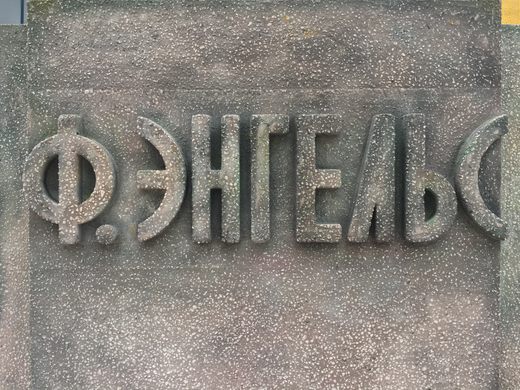Soviet Engels Statue
Manchester salvaged this sculpture of the adopted Mancunian when it was no longer wanted in Ukraine.
The 19th-century Prussian writer, philosopher, and social scientist Friedrich Engels had strong links with Manchester. As a young man, in 1842, he was sent to the English city to work in a mill owned by his family. He would spend the best part of the next 30 years in the region, and the city would play a key role in his development as an innovative socialist and economic thinker.
It was in Manchester that Engels met his long-time romantic partner Mary Burns. Guided by Mary, he came to fully experience industrial working conditions and the plight of the poorest in society. Manchester subsequently served as the inspiration for researching his first book, The Condition of the Working Class in England.
Engels’s writings and studies continued while he lived in the city and carried on working for the family firm. He reportedly enjoyed going out drinking in Manchester and would also invite Karl Marx up from London so that they could collaborate together in Chetham’s Library. In 1848, Engels and Marx co-authored The Communist Manifesto.
Despite Engels’ prominence in the city’s history, however, Manchester didn’t have a monument dedicated to its adopted son until recently. The artist Phil Collins remedied the situation in the summer of 2017, but not by sculpting a fresh piece of artwork. Instead, he went East and brought home an unwanted souvenir reckoned to have been crafted in the 1970s.
As a socialist icon, many statues of Engels were erected across the Soviet Union and the Eastern Bloc states. Following the end of the Cold War, however, these statues were pulled down and destroyed or discarded.
Collins found this particular likeness of the socialist thinker dumped in an agricultural compound in a small village of Poltava in Ukraine (a country which outlawed signs and symbols from the Communist era in 2015). It was cut in half at the waist, covered in raffia bags and bore traces of blue and yellow paint, the Ukrainian national colors. (These colors are still visible on the restored statue.)
Determined to bring Engels back to his long-time home, Collins turned the long journey back to England into an artistic project as part of the Manchester International Festival. After a passage through Europe with stops at key locations in Engels’s life, the statue now has a permanent place in Manchester city center.
Standing tall in a public square outside a relatively new performing arts center, the striking Soviet statue brings a touch of personality to an area of modern development, and serves as another monument representing Manchester’s radical heritage.
Know Before You Go
Engels is easily found standing in front of the HOME performing arts center in Tony Wilson Place. Tony Wilson Place is just off Whitworth Street, opposite the Hacienda apartments. The nearest train stations are Manchester Deansgate and Manchester Oxford Road (Both stations are on Whitworth Street). The Deansgate-Castlefield Metrolink station is also just across the road from Tony Wilson Place, as is the towpath for the Rochdale canal.




























Follow us on Twitter to get the latest on the world's hidden wonders.
Like us on Facebook to get the latest on the world's hidden wonders.
Follow us on Twitter Like us on Facebook